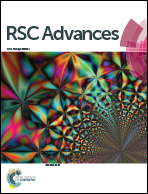Length evolution of helical micro/nano-scale structures†
Abstract
Helical structures frequently exist in nature, and two commonly-seen examples are the curly hair of humans and the helical fujiko of luffa. Helical micro/nanoscale crystals have evolved to be an increasingly-intriguing form of crystals since their first cited observation more than half a century ago. In addition to carbon, a number of other materials have also been found to form helical structures spontaneously or in the presence of metallic catalysts. The special shape with extensive lattice strain, typically triggering a variety of unusual properties, makes such crystals of particular interest to the materials field. Up to this point, the growth kinetics of such helical nanocrystals still remains elusive. To resolve the growth kinetics, one must comprehend the length evolution in the growth of helical structures. In this report, we derive the analytical expression of the length of helical structures. We then evaluate the correlation between the kinetic length of helical crystals and a number of important parameters including the height, diameter and helical pitch, which are all observable via common optical and electronic microscopic techniques. Our investigation is applicable to explain not only the helical growth kinetics at the micro/nano-scale in the materials field, but also the helical growth phenomena in nature in general.


 Please wait while we load your content...
Please wait while we load your content...